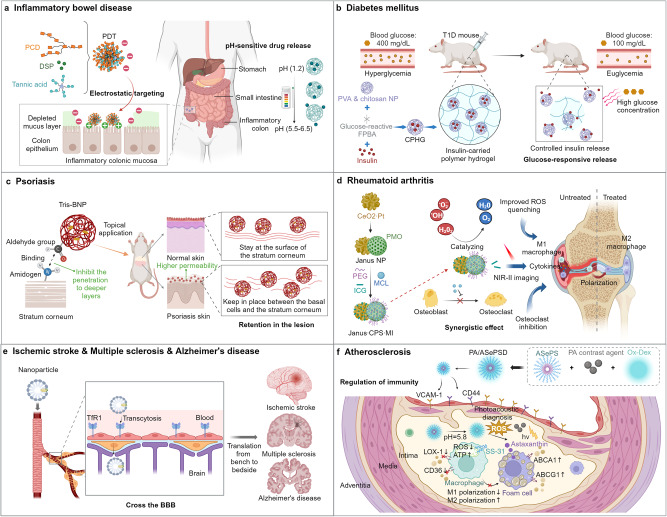Fig. 5.
Overview of the mechanisms of NP treatment for inflammatory diseases. a An oral PDT that treats IBD by combining tannic acid and poly-β-cyclodextrin carrying DSP through host-guest interplay. PDT is electronegative as a result of its three parts, allowing it to electrostatically draw and target the electropositive, inflammatory colon mucosa.803 b CPHGs for regulated insulin release in the therapy of diabetes. A glucose-reactive FPBA-derived linker is used to join PVA and chitosan NPs.509 c Tris-BNPs are able to permeate solely psoriatic skin and not normal skin because of the extreme penetrability of psoriasis. Tris-BNPs gradually fade away as they spread and enter the epidermis, revealing the aldehyde chains of the BNPs, which could stick to amine chains lesional skin, enabling long-term local holding of BNPs in psoriasis skin lesions.524 d A Janus nanoplatform (Janus-CPS) for the concurrent early detection and combinatorial treatment of RA, which is made up of CeO2-Pt nanozyme on one part and PMO on the other. MCL, which has anti-osteoclastogenesis properties, is packed into the PMO’s mesopores to work in concert with nanozymes’ soothing properties to effectively manage RA. The NIR-II fluorescence imaging is employed by ICG-carried Janus-CPS to achieve the desired efficacy in the early detection of RA.162 e NPs penetrate the BBB through TfR1-mediated transcytosis to access the CNS, thereby treating diseases such as IS, MS, and Alzheimer’s disease. f SS-31 polypeptide and astaxanthin are combined in PMeTPP-MBT (a unique PA contrast agent)-loaded, smart reactive theranostic nanoplatform (PA/ASePSD). Targeting atherosclerotic lesions is enabled by PA/ASePSD’s high affinity for VCAM-1 and CD44 on impaired endothelium. Astaxanthin, SS-31 peptide, and PMeTPP-MBT are released in regulated conditions when ROS levels in acid are increased. This enables non-intrusive PA diagnostics and plaque reduction via soothing effects and lipid metabolic control.804 PCD poly-β-cyclodextrin, PDT polyphenol nanoparticle, PVA poly(vinyl alcohol), FPBA formylphenylboronic acid, CPHG chitosan NPs/PVA hybrid hydrogel, ICG indocyanine green, MCL micheliolide, ox-Dex oxidized dextran, PA photoacoustic, VCAM-1 vascular adhesion molecule-1, LOX-1 lectin-like oxidized low-density lipoprotein receptor-1, ABCA1/G1 ATP-binding cassette transporter A1/G1

